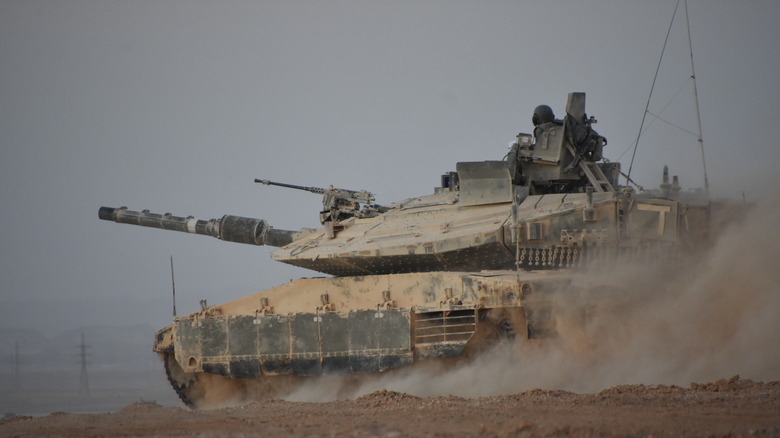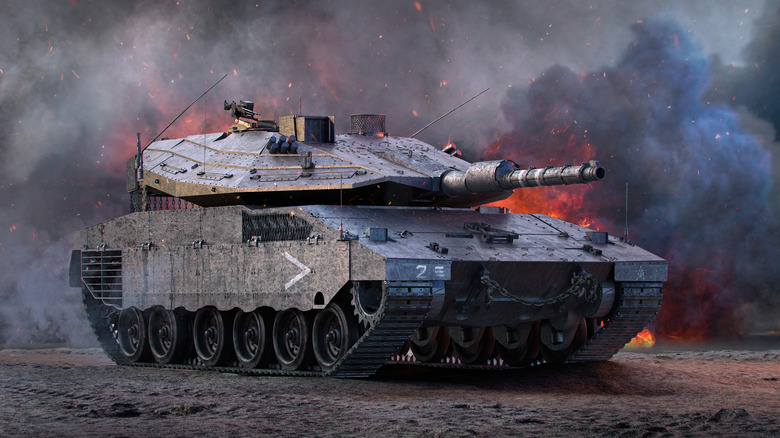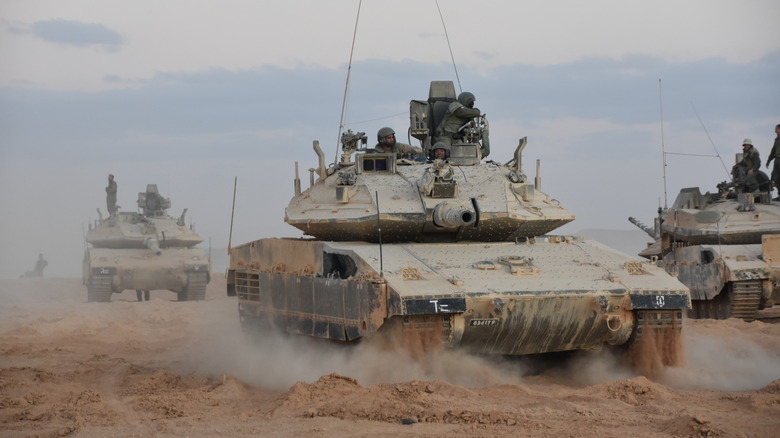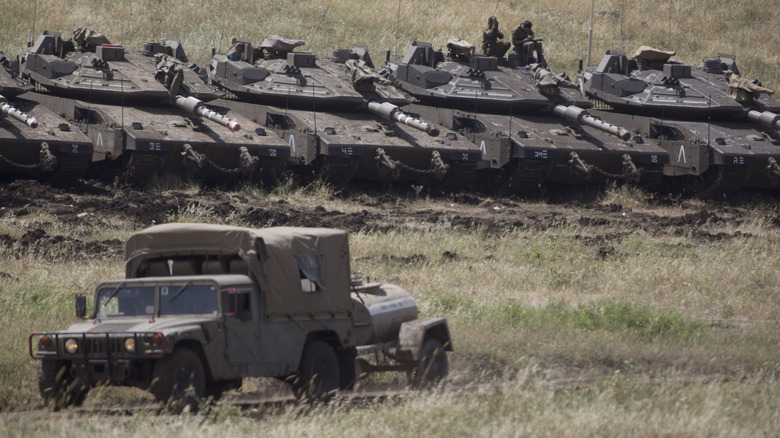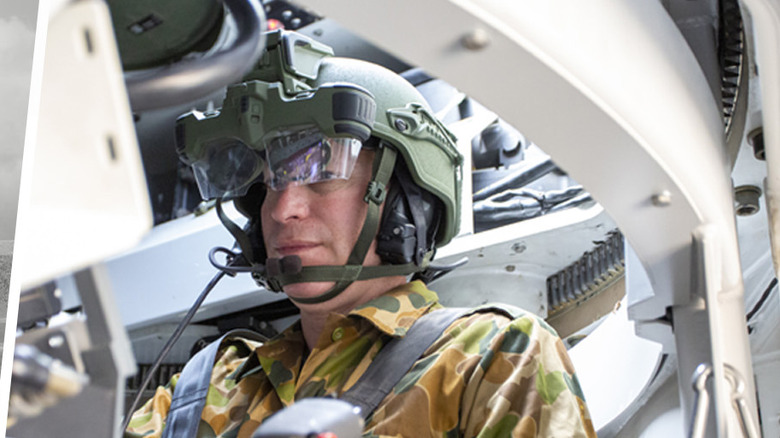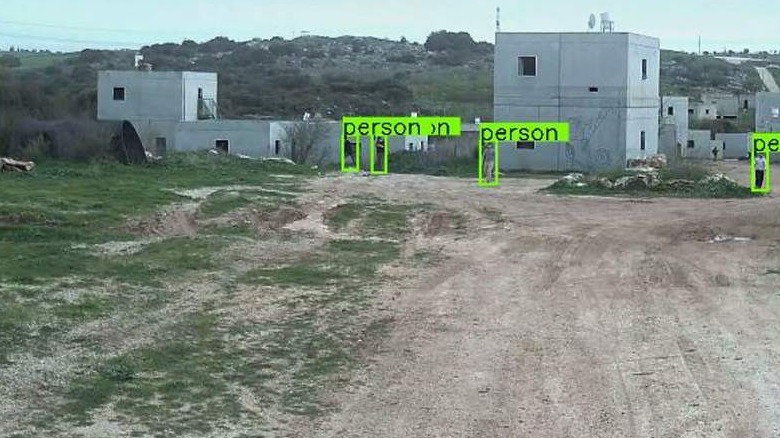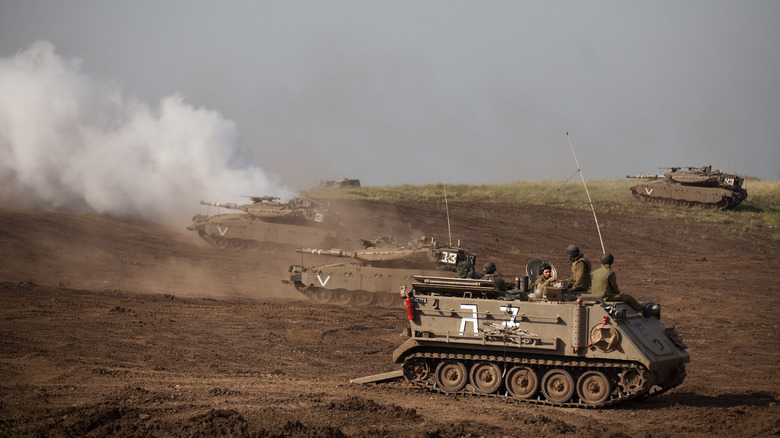All About The Israel-Made Merkava Main Battle Tank
In 1967, Israel used the American M48 and British Centurion tanks to storm the Sinai Peninsula in a pre-emptive strike, which led to the end of the Six-Day War. However, this didn't come without consequences, as many of its allies, like the United Kingdom, did agree with their decision and withdrew their commitments, such as its planned joint tank-development project.
Knowing this, it is unsurprising that the development of what we now know as the legendary Merkava main battle tank began a few years later, in 1970. Under the leadership of Major General Israel Tal, former commander of the Israel Defense Forces (IDF) Armored Corps who led the victory at Sinai, Israel embarked on a mission to reduce its reliance on foreign powers for its military vehicles. After almost a decade in development, the first Merkava main battle tank began its service in 1979.
Since then, the Merkava main battle tank, which means "Chariot" in Hebrew, has been a staple in the IDF arsenal and has undergone several iterations. However, what simply began as a journey to build an indigenous Israeli tank also led to it building one of the most impressive tanks of all time. Here's what makes the Merkava main battle tank so special and what its future could look like.
What makes the Merkava main battle tank special
Before the Merkava was designed, Israel had no experience in making large armored vehicles. However, it did strive to create a tank that fit its specific needs as a small country that needed to keep its soldiers as safe as possible. Because of this, the Merkava battle tank was designed with protection as the priority.
For this reason, the Merkava employed a unique design wherein its engine and transmission were located in front of the vehicle, acting as a shield for the tank's inhabitants. Aside from this, it also stored ammo in protective containers and had fast-reacting fire suppression mechanisms to avoid explosions. However, these same changes also introduced unique issues to the Merkava, especially with risks of frontal attacks damaging the engine quickly.
Despite this, the Merkava retained these traits across its various iterations. Since 2004, the IDF began using its fourth version, the Merkava IV, as its main battle tank. It could hold eight infantry soldiers, had an all-electric turret, and a protection suite that used electromagnetic threat identification. The Merkava IV is fitted with the Trophy Active Protection System (APS), which provides coverage for threats while launching countermeasures.
According to Army Technology, the Merkava IV's engine components are manufactured by German company MTU and USA-based General Dynamics Land Systems manufactures its GD 883 engine under licensed production. However, the Jerusalem Post claims that 90% of the components in the Merkava IV are locally produced.
The introduction of the Merkava Barak
In September 2023, Israel began delivery of the Merkava Barak, the next generation of its Merkava battle tanks. A joint development between Israel's Armored Vehicles Directorate and the IDF's Ground Forces and Armored Corps, the Barak uses various systems developed by Israeli defense firms, such as Elbit Systems and Rafael.
Despite being one of the most expensive military tanks ever built, the Merkava's new features can definitely be worth the money. The Globe reports that the cost of the Merkava Barak is $3.5 million, which is similar to the Merkava IV.
With its latest iteration, the Merkava Barak upholds the values of its predecessors, including similar automotive elements like the engine. It also uses the Trophy Active Protection System (APS) like its predecessor, the Merkava IV. The Merkava Barak does introduce improved sights and an upgraded Fire Control System (FCS), as well as changes that it hopes will improve the user experience of its young soldiers, like adding multi-touch screens that mimic smartphone interfaces.
In a statement to the European Defense Review, Idan Tavor, Elbit Systems' VP for Advanced Combat Vehicle Systems, shared, "We worked on it pretty hard for the last two years in order to make it very approachable for young soldiers who are used to their cell phones and playstations." However, at the core of the new Merkava Barak's new features is how it integrates artificial intelligence.
Ushering in the future of AI-integrated battle tanks
For years, Israel has been investing heavily in using artificial intelligence (AI) for its military vehicles. In fact, it's no secret that even other tank models have had a taste of AI upgrades in recent times.
In 2022, the Israel Ministry of Defense already revealed plans for its AI-powered robotic drone tanks, which were designed to refine things like target recognition, tracking, and prioritization. Knowing this, it is unsurprising that the latest generation of the Merkava tanks also received a few AI upgrades.
Following a five-year development process, the Tank and APC Administration in the Ministry of Defense and the IDF reveal the IDF's future tank: the "Barak." Equipped with advanced sensors and AI processing, the future tank will further strengthen IDF readiness and capabilities. pic.twitter.com/LdoEXA7kym
— Ministry of Defense (@Israel_MOD) September 19, 2023
In a tweet on its X, formerly known as Twitter page, the Israel Ministry of Defense (MOD) shared that the Merkava Barak will be equipped with advanced sensors and AI processing. In tandem with the Torch 750, the IDF's digital combat system, this will enable Merkava Barak to send and receive real-time battlefield data like never before.
But how does it help exactly? One way is to improve situational awareness for its commander by feeding relevant information while the tank remains completely sealed.
The impact of IronVision
In previous Merkava models, commanders would need to open the hatch to get a 360-degree view, which puts additional risk to the crew. On its website, Elbit Systems shares that IronVision can help crew members 'see through' the vehicle's armor. In a statement to The Times of Israel, the ministry said, "The system will allow 360-degree scanning by moving the head and locating targets in real-time with the help of artificial intelligence capabilities."
Through the years, Elbit Systems has made a name for itself as a leader in the field of Helmet Mounted Systems. In a press release, Collins Elbit Vision Systems, a subsidiary of Elbit Systems, also announced delivering 3,000 F-35 Gen III Head-Mounted Display (HMD) to the Joint Strike Fighter in 2024.
Using pre-loaded terrain and distortion-correction algorithms designed to manage visual distortions, IronVision can help prevent motion sickness, which can be a common issue for soldiers in armored vehicles. In addition, with its patented Augmented Reality Integrated Training System (ARTIST), Elbit Systems also mentions that Iron Vision can simulate combat-accurate scenarios for cost-effective training programs.
The future of the Merkava battle tank
In 2023, Reuters reported that Israel began talks to sell its Merkava tanks to two countries, citing high demand for Israeli products due to countries replenishing arsenals after providing weapons to Ukraine. However, months later, Calcalistech shared that the historic deal was canceled due to the IDF's ongoing efforts to rebuild its armed forces due to the ongoing conflict in Gaza.
One thing is for sure: The true impact of the Merkava Barak's technological advances on the future of battle tanks is still underway. As Israel continues to iterate and improve its tank capabilities, it's only a matter of time before the use of real-time data and advanced helmet technology becomes the norm for the next generation of modern war vehicles.
Additionally, with the introduction of AR training capabilities for its new IronVision feature, the shift from training to the battlefield may not feel as drastic for new soldiers. Not only can this mean faster training periods before new recruits are battle-ready, but it could also lead to higher survivability, in line with Israel's longstanding position on protection-first promise for its soldiers.
